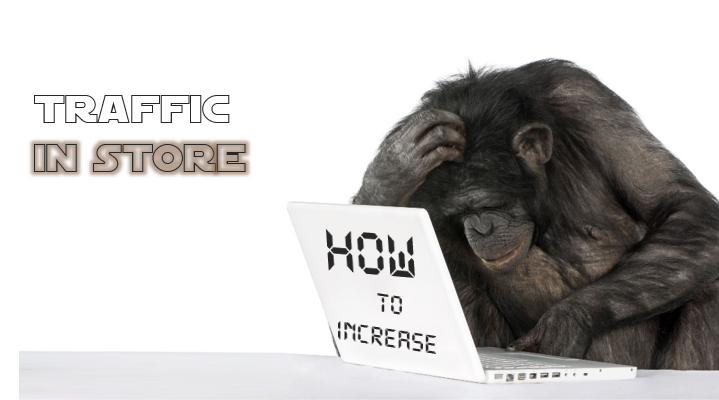In-store traffic: a permanent obsession of the retailer
How to act on the levers for increasing in-store traffic in the digital age ?
Mourad Piron
8/27/20254 min read


Can we really act on the increase of the traffic in the store?
This is a question that many retailers probably ask themselves on a daily basis.
Or even that they stopped asking it. Not because they are no longer concerned about trafficking. But most certainly because brands are no longer finding answers to the ones they already have.
Levers for increasing traffic
Indeed, to increase traffic, here is a non-exhaustive list of levers that almost everyone has already thought of:
Visual merchandising (especially window displays)
o All retailers have a visual merchandising team. And it is trained to respect the visual identity codes. Unfortunately, there is a lack of communication between store management and VM teams about the flow of in-store traffic. And then the "customer" or rather prospect is already in the store. Or at worst he passed in front of the shop, so the only lever would be the windows or the brand
The location of the store, corner
o The store management teams have no influence on the choice of store location. Other parameters are taken into account, such as the price per square metre. The catchment area etc. And this has an almost direct impact on traffic. A store on Avenue Montaigne will not have the same amount of traffic as the one in Cannes on the Croisette. So the lever on the increase in traffic for the store manager is zero.
Branding
o Strongly worked (especially in the luxury sector) to capitalize on the attractiveness of the brand – On the other hand, the traffic will be mainly made up of "acquired" customers....the others who are not fans, well "too bad" for them.
Clienteling
o or the activity of the sales consultant to contact customers or prospects (who have already been to the store but who have not bought, a paradox). Except that salespeople focus mainly on their existing customers because they know them well. And so the increase in traffic is biased. Except in the case of external factors that prevent traffic in a store (a pandemic, a lockdown, construction work, etc.). In these specific cases, it is an excellent lever for increasing traffic.
Marketing activities below the line
o Flyers, leaflets, in-store promotions etc.
Etc...
Brands are not exploiting the potential of social selling enough to increase traffic!
Another permanent obsession of any retailer is turnover. Sell more all the time. Sell more than before. And yet they all have a customer-centric discourse.
But in reality, it's selling more. There is not a brand that does not have a budget to achieve higher than that of the period n-1 in comparison. However, it is not the products or services that make our results. It is the customers who buy them. So more sales is also (but not only) thinking about how to increase your traffic. However, brands are thinking about how to sell more. Enter the idea of omnichannel. Optimized every sales channel. And therefore e-commerce, digital sales, etc. On the other hand, it does not really contribute to increasing in-store traffic. Of course there is click & collect, in-store collect, etc., which bring traffic to the store. But in 99% of cases, the customer is not in buyer mode. And unless the salesman has a crazy talent or a huge stroke of luck, there will be no act of buying. And here is the conversion rate impacted downwards.
In short, it doesn't help the management of the store
And yet there is still a lever that is poorly exploited to increase traffic
In the digital age, of a pandemic that has left us all at home, with the concept of essential and non-essential shops, some (non-essential) have nevertheless done well. They simply took an interest in their customers. How? Well, quite simply by understanding how their customers work on their buying journeys. And it's no secret: the first place where traffic is dismissed is on the web. Just look at the number of searches made on google every day. The prospects are there. But often ignored by brands, or even worse, because brands make themselves invisible. Because they are focused on their navel. This is called branding. Because they missed the upheaval in sales that bring the appearance of the web.
3 things to remember
Each retail director must be able to link the different stages of customer maturity and the SEO rules that could impact the result of his business. It will be able to target customers who are in purchase mode to attract them to its network and consequently increase its traffic.
Each merchant must make himself visible on the net. If only to create web traffic to store. There are more than 40 million transactions in France on the web.
Every B2C entrepreneur must integrate a lead scoring system into their CRM to allow their sales representatives to contact "hot prospects". This is another way to impact its traffic upwards.
Actually not 3 but rather 1 thing to remember
The 3.0 retailer, regardless of his title (CEO, GM, store manager etc.), must catch up on digital. 100% of prospects are first looking for information on the web. Not being present is a monstrous strategic mistake. Being poorly present, by not being referenced naturally, is missing the turn of the web. Apart from the fast-fashion, DNVB brands etc. that have managed to get out of it or even to do better, have simply played the game of social selling to continue to have traffic and therefore to sell.


